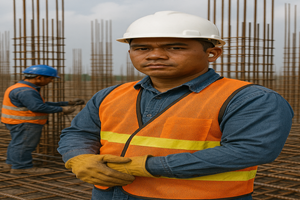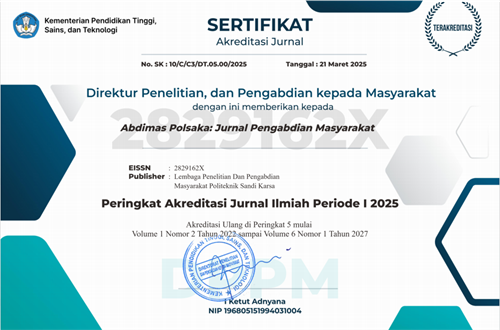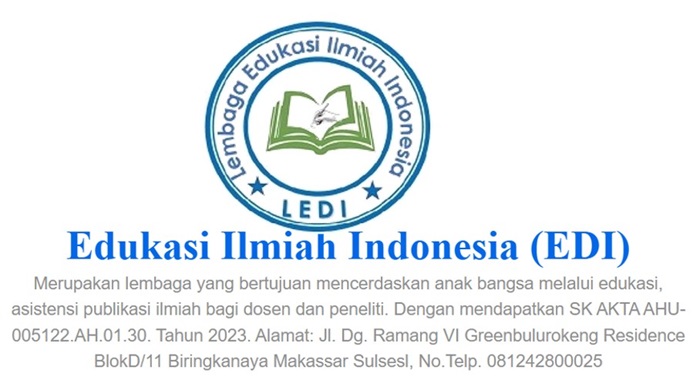Personal protective equipment as a measure to limit disability among ironworkers in maros regency
DOI:
https://doi.org/10.35816/abdimaspolsaka.v4i2.111Keywords:
Iron craftsmen, PPE, Disability LimitationAbstract
Amidst the onslaught of modernization, traditional handicrafts still hold a unique appeal. One such craft is blacksmithing. Blacksmiths, despite their high level of skill in producing handicrafts, often face serious health and safety risks due to exposure to burning, heavy equipment use, and direct contact with hazardous materials. Observations at the partner site revealed workplace accidents such as burns (35.8%), contact with hot iron (58.7%), and being struck by iron materials (35%) due to the nature of their work. Based on these issues, community service activities were conducted in the form of education on the use of personal protective equipment (PPE) as an effort to limit disabilities among iron craftsmen. The results of the education on the benefits of PPE showed an increase in knowledge, attitude, and behavior, with pre-test results of 65%, 77%, and 85%, respectively, and post-test results of 83%, 89%, and 91%, respectively. In the results of the education on the benefits of fire extinguishers, there was an increase in knowledge, attitude, and behavior, with pre-test results of 75%, 80%, and 85%, respectively, and post-test results of 88%, 83%, and 90%, respectively. It can be concluded that the effectiveness of this community service program was successful
Downloads
References
S. C. Nisa and S. A. Fachrin, “Faktor yang Berhubungan dengan Tindakan Tidak Aman pada Pekerja di PT. Industri Kapal Indonesia (Persero) Makassar,” Wind. Public Heal. J., vol. 2, no. 4, pp. 636–647, 2021, doi: https://dx.doi.org/10.47007/hp.v2i02.4177.
N. M. Ramli and S. Suharni, “Penerapan Sistem Manajemen Keselamatan dan Kesehatan Kerja di RSUD Labuang Baji Makassar Tahun 2023,” J. Muslim Community Heal., vol. 4, no. 4, pp. 99–111, 2023, doi: https://dx.doi.org/10.57213/tjghpsr.v1i4.216.
A. Suryana, N. Darna, F. F. Noorikhsan, and R. Maulana, “Pemberdayaan masyarakat perajin pandai besi kampung dokdak dalam pengembangan Desa Karya Berbasis Kearifan Lokal Untuk Mengurangi Pengangguran Di Desa,” Abdimas Galuh, vol. 6, no. 1, pp. 70–81, 2024, doi: https://dx.doi.org/10.25157/ag.v6i1.12399.
A. Suryana, S. Pajriah, E. Nurholis, and A. Budiman, “Nilai-Nilai Kearifan Lokal Masyarakat Kampung Dokdak Desa Baregbeg Kecamatan Baregbeg Kabupaten Ciamis Berbasis Budaya Galuh,” J. Artefak, vol. 10, no. 1, pp. 105–116, 2023, doi: https://dx.doi.org/10.25157/ja.v10i1.10166.
I. Pusnita, A. Apriyani, and M. Marleni, “Pengembangan Pengrajin Pandai Besi Untuk Kesejahteraan Masyarakat Di Desa Mandi Angin Kecamatan Indralaya Selatan Kabupaten Ogan Ilir,” J. Abdimas Indones., vol. 2, no. 3, pp. 439–444, 2022, doi: https://dx.doi.org/10.53769/jai.v2i3.327.
R. M. R. Riri, S. A. Fachrin, and A. Asrina, “Identifikasi Risiko Kecelakan Kerja Terhadap Pekerja Di PT. IKI Makassar Tahun 2020 (Studi Pada Pekerja Proses Marking),” J. Aafiyah Heal. Res., vol. 1, no. 2, pp. 19–27, 2020, doi: https://dx.doi.org/10.52103/jahr.v1i2.142.
D. N. Pratama, “Identifikasi risiko musculoskeletal disorders (MSDS) pada pekerja pandai besi,” Indones. J. Occup. Saf. Heal., vol. 6, no. 1, p. 78, 2017, doi: https://dx.doi.org/10.20473/ijosh.v6i1.2017.78-87.
A. Ridwan, S. Susanto, S. Winarno, Y. C. Setianto, E. Gardjito, and E. Siswanto, “Sosialisasi Pentingnya Penerapan Keselamatan dan Kesehatan Kerja (K3) Pada Karyawan Pabrik Semen Tuban,” J. Abdimas Berdaya J. Pembelajaran, Pemberdaya. Dan Pengabdi. Masy., vol. 4, no. 01, pp. 36–41, 2021, doi: https://dx.doi.org/10.30736/jab.v4i01.87.
A. Wahyu, F. Naiem, T. Abdullah, and Y. Thamrin, “Metode edukasi & pendampingan terhadap peningkatan kesadaran terkait penggunaan APT pengrajin pandai besi,” J. Kesehat. Masy. Marit., vol. 2, no. 2, 2019, doi: https://dx.doi.org/10.30597/jkmm.v2i1.8722.
I. E. Riantono, “Pengelolaan manajemen modern dalam mewujudkan good corporate governance: Optimalisasi pencapaian tujuan perusahaan,” Binus Bus. Rev., vol. 5, no. 1, pp. 315–322, 2014, doi: https://dx.doi.org/10.21512/bbr.v5i1.1219.
A. Santoso and M. Istizar, “Penguatan Pemahaman Strategi Branding melalui Pendampingan Daring bagi Anggota Asosisasi Pusat Pengembangan Sumberdaya Wanita,” 2020, [Online]. Available: https://www.google.com/search?q=issn%2714-6286.
A. Sasongko, “Republika. Retrieved Agustus 2023.” 2019.
A. B. Sulistio, “Branding Sebagai Inti Dari Promosi Bisnis,” Wati, AP al.(2020). Digit. Mark. Malang Edulitera (Anggota IKAPI–No. 211/JTI/2019) Impr. PT. Literindo Berkah Karya, 2021, [Online]. Available: https://www.mendeley.com/catalogue/319f1a01-8da4-3551-ac64-7d4d3b7107d8.
M. Chankseliani, I. Qoraboyev, and D. Gimranova, “Higher education contributing to local, national, and global development: new empirical and conceptual insights,” High. Educ., vol. 81, no. 1, pp. 109–127, 2021, doi: https://dx.doi.org/10.1007/s10734-020-00565-8.
S. Sumarto, “Budaya, pemahaman dan penerapannya:‘Aspek sistem religi, bahasa, pengetahuan, sosial, keseninan dan teknologi,’” J. Literasiologi, vol. 1, no. 2, p. 16, 2018.
A. Supriyanto, “Mengenal Sejarah Pande Besi Tradisional,” Ornamen, vol. 8, no. 1, 2011.
D. Meiliani Yulis, L. Fitriyani, A. Purwoto, N. Cholifatul Izza, A. Fahri, and S. Suprapto, “Peningkatan Kompetensi Kader Posyandu Lansia Dalam Merawat Luka,” Abdimas Polsaka, vol. 2, no. 1 SE-, pp. 1–6, Mar. 2023, doi: https://doi.org/10.35816/abdimaspolsaka.v2i1.24.
J.-J. Wang and N.-Y. Tsai, “Factors affecting elementary and junior high school teachers’ behavioral intentions to school disaster preparedness based on the theory of planned behavior,” Int. J. Disaster Risk Reduct., vol. 69, p. 102757, 2022.

Additional Files
Published
How to Cite
Issue
Section
License
Copyright (c) 2025 Suharni A.Fachrin, Alfina Baharuddin, Fatma Jama, Hukma Ratu Purnama, Yuliati Yuliati, Ella Andayanie

This work is licensed under a Creative Commons Attribution 4.0 International License.
Most read articles by the same author(s)
- Yuliati Yuliati, Alfina Baharuddin, Hardi Hardi, Siti Astachya Ananda Sofyan, Suharni A. Fachrin, Ella Andayanie, Optimizing clean water filtration through the application of science and technology: Reverse osmosis method , Abdimas Polsaka: Vol. 4 No. 2 (2025): Abdimas Polsaka: Jurnal Pengabdian Masyarakat
- Ella Andayanie, Alfina Baharuddin, Asmarani Harma, Annisa Junaid, Yuliati Yuliati, Suharni A. Fachrin, Clean Water Self-Sufficiency and Well Water Filtration Method Education for Health Workers in Gowa Regency , Abdimas Polsaka: Vol. 4 No. 2 (2025): Abdimas Polsaka: Jurnal Pengabdian Masyarakat




















